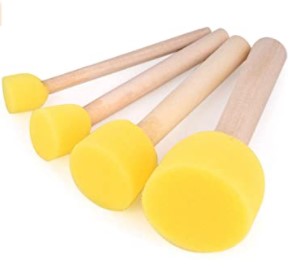Have you ever browsed the paint brush section at your local Art Supply store? We both know those aisle are overwhelming with the amount of choices. There is long handles, short handles, synthetic, plastic, natural bristles, flats, rounds, blenders, etc. Well, for beginners we recommend a synthetic (nylon) brush. Natural brushes tend absorb more water if left too long in your water cup, and can cause them to feel soppy and lose their form quicker. Synthetic brushes are more resilient to water and acrylics. Synthetics are great for oil painting as well. Make sure to always clean your brushes thoroughly with care, as the results could leave your brushes with a bad hair day.

Flat ferrule, short-length hairs, set with longer hairs at one end. Useful for precise strokes, and for lines and curves, with thick or heavy color.

Flat ferrule, short-length hairs, usually set in a long handle. Width and length of brush head is about equal. Useful for short, controlled strokes, and with thick or heavy color.

Flat ferrule, spread hairs. Natural hair is more suitable for soft blending, and synthetic works well for textural effects. Useful for smoothing and blending, special effects and textures.

Thick, flat ferrule and oval-shaped medium to long hairs. Long handles. Natural hair is more suitable for blending because the hairs hold together when wet. With its soft rounded edges, the filbert is suitable for blending and figurative work.

Flat ferrule, square-ended, with medium to long hairs. Provides lots of color capacity and easy maneuverability. Use for bold, sweeping strokes, or on edge for fine lines. Use heavier filling for heavier paint. These brushes are marked with measurements right on the metal fixing. They are great for bold wide strokes of color and filling in your background. Very easy to control.

Round brushes have a round ferrule and a round or pointed tip that is useful for painting thin to thick lines, and for creating details, washes, and fills in oil, acrylic, or watercolor paintings. The most traditional of the brush shapes, a round paintbrush is what most people imagine when they think about a paintbrush. Pointed rounds are ideal for creating fine details, while another variation on the round brush, the detailer, is a pointed round with very short fibers. A round brush may contain natural fibers, synthetic fibers, or a combination of natural and synthetic fibers that perform as well or better than their natural counterparts.

Also known as a Rigger Brush. They are a pointed, narrow brush with very long hair. Liners are shorter and narrower. Short handles, round ferrules. Large color carrying capacity. Useful for delicate lettering, highlighting, outlining, and long continuous strokes.
Sponges, daubers, and Q-tips are a great way to add texture into your painting without a lot of work.



The rest is up to you. Of course, it is always a matter of personal choice when it comes between choosing long handles or short. Whatever you feel most comfortable using will be best. Brushes are tools and should feel comfortable and be an extension of your hand.
